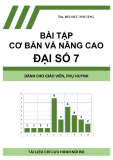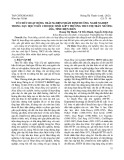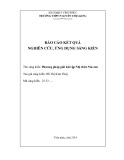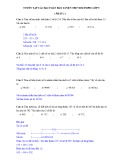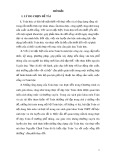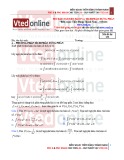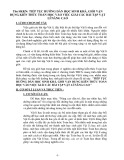THE INDEPENDENCE NUMBER OF DENSE
GRAPHS WITH LARGE ODD GIRTH
James B. Shearer Department of Mathematics IBM T.J. Watson Research Center Yorktown Heights, NY 10598 JBS at WATSON.IBM.COM
Submitted: January 31, 1995; Accepted: February 14, 1995
1 k¡1
Abstract. Let G be a graph with n vertices and odd girth 2k + 3. Let the degree of a vertex v of G be d1(v). Let fi(G) be the independence number of G. Then we show " #(k¡1)=k X fi(G) ‚ 2¡( k¡1 k ) . This improves and simplifles results proven by d1(v)
v2G
Denley [1].
AMS Subject Classiflcation. 05C35
Let G be a graph with n vertices and odd girth 2k + 3. Let di(v) be the number of points of degree i from a vertex v. Let fi(G) be the independence number of G. We will prove lower bounds for fi(G) which improve and simplify the results proven by Denley [1]. We will consider flrst the case k = 1. We need the following lemma. Lemma 1: Let G be a triangle-free graph. Then
X fi(G) ‚ d1(v)=[1 + d1(v) + d2(v)]:
v2G
X Proof. Randomly label the vertices of G with a permutation of the integers from 1 to n. Let A be the set of vertices v such that the minimum label on vertices at distance 0; 1 or 2 from v is on a vertex at distance 1. Clearly the probability that A contains a vertex v d1(v)=[1 + d1(v) + d2(v)]. is d1(v)=[1 + d1(v) + d2(v)]. Hence the expected size of A is
v2G
Furthermore, A must be an independent set since if A contains an edge it is easy to see that it must lie in a triangle of G a contradiction. The result follows at once.
Typeset by AMS-TEX
1
2
(cid:1)(cid:2)(cid:3) (cid:3)(cid:4)(cid:3)(cid:5)(cid:1)(cid:6)(cid:7)(cid:8)(cid:9)(cid:5) (cid:10)(cid:7)(cid:11)(cid:6)(cid:8)(cid:12)(cid:4) (cid:7)(cid:13) (cid:5)(cid:7)(cid:14)(cid:15)(cid:9)(cid:8)(cid:12)(cid:1)(cid:7)(cid:6)(cid:9)(cid:5)(cid:16) (cid:17) (cid:18)(cid:19)(cid:20)(cid:20)(cid:21)(cid:22)(cid:23) (cid:24)(cid:25)(cid:17)
We can now prove the following theorem.
Theorem 1. Suppose G contains no 3 or 5 cycles. Let „d be the average degree of vertices of G. Then q
fi(G) ‚ n „d=2:
X X Proof. Since G contains no 3 or 5 cycles, we have fi(G) ‚ d1(v) (consider the neighbors of v) and fi(G) ‚ 1 + d2(v) (consider v and the points at distance 2 from v) for any vertex v of G. Hence fi(G) ‚ d1(v)=2fi(G) (by lemma d1(v)=[1+d1(v)+ d2(v)] ‚
v2G
v2G
p 1 and the preceding remark). Therefore fi(G)2 ‚ n „d=2 or fi(G) ‚ n „d2 as claimed. This improves Denley’s Theorems 1 and 2. It is sharp for the regular complete
bipartite graphs Kaa. The above results are readily extended to graphs of larger odd girth. Lemma 2: Let G have odd girth 2k + 1 or greater (k ‚ 2). Then
1
X : fi(G) ‚
2 (1 + d1(v) + ¢ ¢ ¢ + dk¡1(v)) 1 + d1(v) + ¢ ¢ ¢ + dk(v)
v2G
Proof. Randomly label the vertices of G with a permutation of the integers from 1 to n. Let A (respectively B) be the set of vertices v of G such that the minimum label on vertices at distance k or less from v is at even (respectively odd) distance k ¡ 1 or less. It is easy to see that A and B are independent sets and that the expected size of A [ B X is . The lemma follows at once. (1 + d1(v) + ¢ ¢ ¢ + dk¡1(v)) 1 + d1(v) + ¢ ¢ ¢ + dk(v)
v2G
Theorem 2: Let G have odd girth 2k + 3 or greater (k ‚ 2). Then
k
1 k¡1
" # k¡1 X : fi(G) ‚ 2¡( k¡1 k ) d1(v)
v2G
Proof. By Lemmas 1, 2
•• ‚ • ‚ X fi(G) ‚ + 1 2 d1(v) 1 + d1(v) + d2(v)
v2G
‚‚
+ ¢ ¢ ¢ + =(k ¡ 1): 1 2 1 + d1(v) + d2(v) 1 + d1(v) + d2(v) + d3(v) • 1 + d1(v) + ¢ ¢ ¢ + dk¡1(v) 1 + d1(v) + ¢ ¢ ¢ + dk(v)
Since the arithmetic mean is greater than the geometric mean, we can conclude that • ‚1=k¡1 X . Since the points at even (odd) distance fi(G) ‚ d1(v)2¡(k¡2) 1 + d1(v) + ¢ ¢ ¢ + dk(v)
v2G
less than or equal k from any vertex v in G form independent sets we have 2fi(G) ‚ 1 +
(cid:1)(cid:2)(cid:3) (cid:3)(cid:4)(cid:3)(cid:5)(cid:1)(cid:6)(cid:7)(cid:8)(cid:9)(cid:5) (cid:10)(cid:7)(cid:11)(cid:6)(cid:8)(cid:12)(cid:4) (cid:7)(cid:13) (cid:5)(cid:7)(cid:14)(cid:15)(cid:9)(cid:8)(cid:12)(cid:1)(cid:7)(cid:6)(cid:9)(cid:5)(cid:16) (cid:17) (cid:18)(cid:19)(cid:20)(cid:20)(cid:21)(cid:22)(cid:23) (cid:24)(cid:25)(cid:17)
3 #
1 k¡1
k k¡1 ‚ 1 2
" • X X ‚ 1 k¡1 or fi(G) d1(v) + ¢ ¢ ¢ + dk(v). Hence fi(G) ‚ d1(v) d1(v) 2k¡1fi(G)
v2G
v2G
k
1 k¡1
" # k¡1 X as claimed. or fi(G) ‚ 2¡( k¡1 k ) d1(v)
v2G
k¡1 k d
1 k :
k )n
Corollary 1: Let G be regular degree d and odd girth 2k + 3 or greater (k ‚ 2). Then
fi(G) ‚ 2¡( k¡1
Proof. Immediate from Theorem 3. This improves Denley’s Theorem 4.
References

